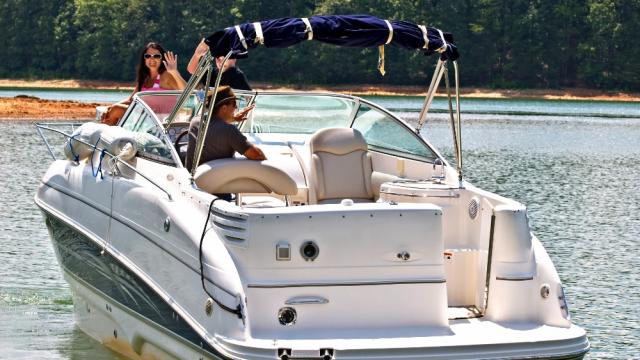If you are ready to take on the wonderful and relaxing world of sailing, then you will need to learn a few things. Here you will learn the most used terminology that you will hear and soon be using yourself.
Boating Terms
 Abeam: This means something lies at the right angle from the boat. Example: The buoy is abeam from us.
Abeam: This means something lies at the right angle from the boat. Example: The buoy is abeam from us.- Aft: The portion of the vessel behind the middle area of the vessel
- Ahead: This means in front of the boat. Example: The land is ahead.
- Astern: This means behind the boat. Example: The competition is astern.
- Beam: This is the widest part of your boat. Example: The boat’s length is 50′, but the beam is 14′.
- Boom: This is the horizontal pole that extends from the bottom of the boat’s mast.
- Bow: This is the front of the boat.
- Crew: These are all those who participate in operating the boat.
- Forward: This is toward the bow.
- Freeboard: This is the height of your deck above the water.
- Helmsman: (also called helmsperson) This is the one that steers the boat.
- Lee and Leeward: (Pronouncing: “lee” and “loo ward”) This is downwind.
- Port: 1 – This is the left side when you are looking forward. 2 – This is a window in the side of your boat. 3 – Location where boats and ships dock.
- Rudder: This is beneath your boat. It is a flat piece of wood, metal, or fiberglass that is used to steer it.
- Running Rigging: This is all of the lines that control any part of your sails, which includes the sheets, outhaul, and halyards.
- Skipper: This is the person who is in charge.
- Standing Rigging: This is all of the wires or the cables that hold up the mast.
- Starboard: This is the right side of the boat when you face forward.
- Windward: This is towards the wind.
Sailing Tips for Beginners
Now that you are aware of the typical terms used while sailing, here is a list of tips to help you when you are a beginner.
- Choose un-crowded and calm water when you are beginning.
- Pick a smaller boat.
- Use a boat rigged with one sail to start.
- Follow all sailing basics for the safety of you and your passengers.
- Research the wind, tide, and weather conditions.
- Get familiar with the control of the sails.
- Capsize to ensure you know how to manage should it happen for real.
- Show respect to the boom.
- Memorize the terms.
- Practice as much as possible.
Learning to sail is very exciting, but make sure to take all rules, regulations, and safety information very seriously!

